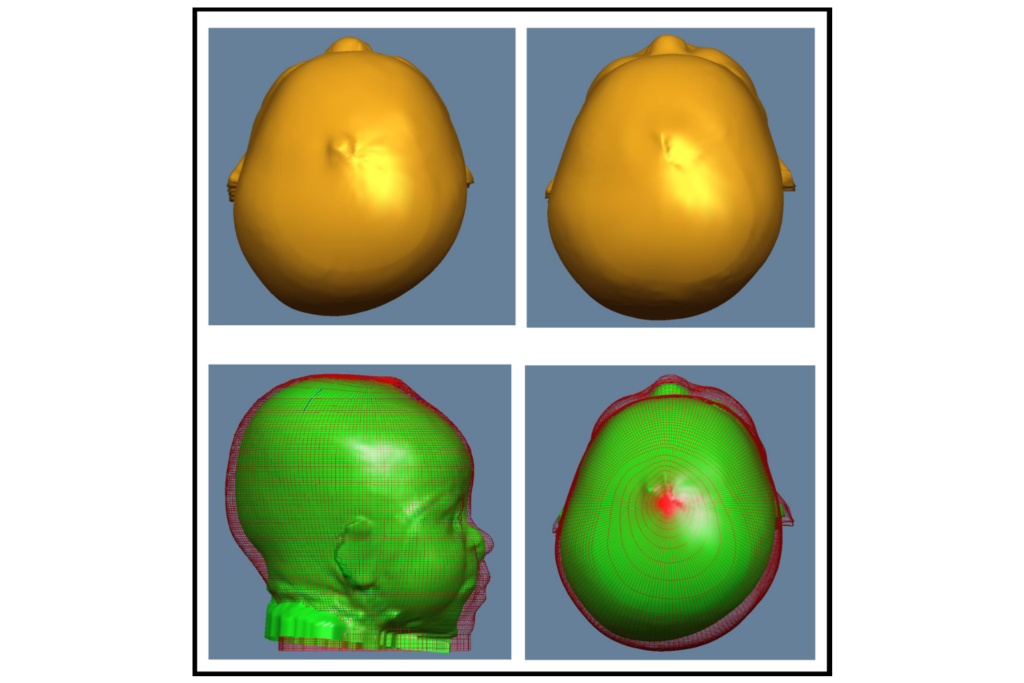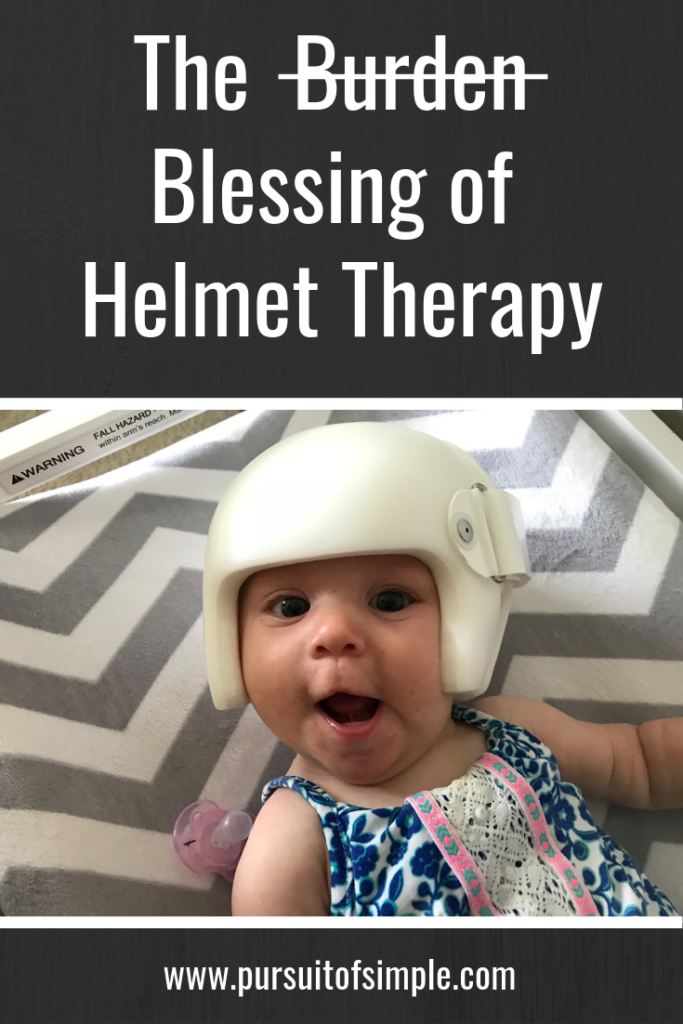This post may contain one or more affiliate product links. Pursuit of Simple is a participant in the Amazon Services LLC Associates Program, an affiliate advertising program designed to provide a means for sites to earn advertising fees by advertising and linking to amazon.com. View my Disclosures to learn more.
Almost six months ago my husband and I met with a nurse practitioner to assess whether one of our twins needed a helmet to correct the asymmetry of her head shape. Baby A, the “compliant” one who was head down for probably 20 weeks of my pregnancy, was unfortunately wedged down in my pelvis while her sister comfortably hogged the rest of my womb. Although we don’t know for sure, my husband and I are pretty convinced this is what caused our daughter to develop plagiocephaly and was also the cause of her torticollis.
What is Plagiocephaly you might be wondering? It’s a medical term that basically means one side of the head, or the back of the head, is flat, making the head and face asymmetrical. If you catch it early enough and are diligent with your efforts, you can sometimes correct the head shape through repositioning your baby. However, repositioning is frequently not enough to correct it completely, and that’s when a helmet is recommended.
In our daughter’s case, her measurements put her just outside the normal range, and the nurse practitioner encouraged us to go through with helmet therapy if we were willing. And if you’re not familiar with how helmet therapy works, allow me (a mom, not a medical professional) to give you a brief, non-technical overview.
Helmet therapy is highly effective because each helmet is customized for a particular infant’s head, leaving gaps where the head needs to grow and round out while applying pressure in areas where growth is not needed. It essentially forces the growth to the right places. However, to be effective, babies should wear the helmet 23 hours per day every day for about three to four months. The only time the helmet should come off is to clean it, to do physical therapy exercises (since most helmet kids also have torticollis), to go swimming, or if the baby is running a fever or experiencing excessive skin irritation.
After the initial helmet fitting appointment, you must bring your baby in for helmet adjustments every two to three weeks, so an orthotist can check your baby’s growth and hollow out areas of the helmet where more shaping of the head is needed. As a parent, you are also responsible for daily checking your baby’s head for persistent skin irritations caused by the helmet. With the investment of time, money, and effort, deciding to go through helmet therapy with your baby is no small commitment on the part of the parents.
After hearing the nurse practitioner’s recommendation and learning what it would be like to go through this process with our daughter, my husband was highly enthusiastic and willing to do whatever it took to correct her head shape. He immediately viewed this as a solution to a problem and didn’t feel burdened by it at all. He was relieved that her head could be corrected by something as simple as having her wear a helmet for a few months.
I wish I could say my response was just as positive as his, but that would be a lie. I immediately felt burdened by her need for a helmet. I was anxious too, and all I could see were the negative aspects of the helmet. I was worried about how much of the cost our insurance would cover. I was nervous about having to drive downtown without my husband every two to three weeks for the adjustment appointments. (I detest driving downtown and get very uncomfortable, hence the reason for the nervousness.)
I felt pity for our daughter. I was sad that she would have to wear a helmet every single day, all day long with only one brief break. Oh, and did I mention it was the beginning of summer when she started this whole process? The orthotist told us it was fine to take her outside, but she instructed us to remove the helmet if it was a particularly warm day. As a result, we ended up playing it safe and didn’t spend as much time outside as we would have liked, which only gave me more fuel for my bitterness.
It also seemed unfair to me that we were having to deal with this when we already had the challenge of raising 5-month old twins (at the time), along with two older kids. I found myself silently asking God why we couldn’t have dealt with this when we had just one or two kids and not when we had twins.
Once our daughter began wearing the helmet, my negativity only got worse. I realized I couldn’t kiss her head, and I could barely kiss her face because the helmet was in the way. It made me very sad that I couldn’t snuggle her the way I could before she got the helmet. And then there’s the smell of the helmet, which we were warned about, but…did I mention we started this in the summer time? Two words capture it perfectly. Dirty feet. If you’re familiar with that smell, then you’ll know exactly how her helmet (and head) smelled every single day, despite the fact we cleaned it daily and followed the instructions we were given.
I also struggled to get the helmet on her the first few times, and though my daughter was screaming and crying at my failed attempt, I’m not sure who threw the worse fit, me or her…
As you can see, I was basically throwing a major pity party for myself. I just kept choosing to see only the negative, despite my husband’s attempts to point out all the reasons why this helmet was good and how we were doing the right thing for our daughter. He kept saying, “We’re gonna look back, and this time will just be a blip on the radar.” And he was right I might add.
Looking back now I don’t remember exactly when something inside of me changed, but something clicked, and I finally realized that this stinky helmet wasn’t a burden at all. It was actually a blessing, and I needed to start seeing it that way. Perspective can change anything.
We were so fortunate that our daughter’s condition was something that has the ability to be corrected with medical intervention. Not only that, it wasn’t even a risky endeavor. As I mentioned, helmets are highly effective when worn for the recommended 23 hours per day, so what we were going through was a temporary, non-painful, and highly successful solution for our daughter.
We live in a country where we have access to this kind of treatment, and our insurance company covered a portion of the cost. What right did I have to complain at all?! When I started realizing all of this, I felt so convicted. I made a conscious effort to begin reminding myself that her helmet was a blessing and not a burden. And now, being on the other side, I hope to be able to encourage moms and dads who are considering helmet therapy, as well as parents who are just getting started with this process.
Perspective is powerful. Nothing about our situation changed except for my perspective, and subsequently, my attitude. When I removed the negative lens I was looking through, I was able to truly view our daughter’s helmet as a blessing and not a burden. I adopted an attitude of gratitude, and the remaining time she wore the helmet seemed to fly by.
And if you’re interested in seeing what a helmet is capable of doing, I’ve included the images of our daughter’s before and after scans. As you can see, her head grew a lot and rounded out in the areas where it was very flat. Her head’s not perfect, but it’s pretty close to being symmetrical now, and it looks so much better than when she started. We had a wonderful experience with Orthotic Care Services and with the orthotist who worked with us throughout the process.

So here we are now, six months later, and she is finally finished with the helmet. She had incredible results, and the progress was definitely worth the investment. I will not miss that helmet one bit, but I am so glad we decided to go through with it. I am so excited to be able to snuggle my daughter again and kiss her head anytime I want to. As simple as it is, I will never take that for granted, and it’s all because of that stinky helmet.



Leave a Reply